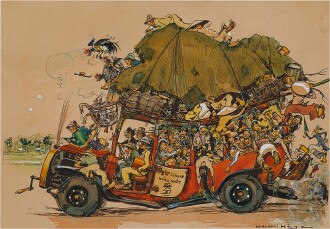L
a Mystique de L’Indochine recalls Vietnam’s Golden Age of art, which spans a fifteen-year period beginning in 1930 with the establishment of the Ecole des Beaux-Arts d’Indochine in Hanoi. The auction brings together a mélange of rich Vietnamese traditions and French allure. Owing to the country’s colonial past, foreign influences are discernible in the art, especially as many pioneers of Vietnamese modern art emigrated to France or had studied at the prestigious Ecole in Hanoi before World War II. Reinterpreting and synthesizing French post-Impressionist trends, prominent artists mastered European techniques and media to express traditional Asian subjects and ideas, thus creating a distinctive style. The works in La Mystique de L’Indochine showcases sentimentalized vignettes rendered with oil paint, watercolor and lacquer. Artists found themselves entrenched in a new canon of modern art, which ultimately developed into a delightful integration of Vietnamese and French artistic styles.

Some of the graduates of the Ecole des Beaux-Arts d’Indochine would move to Paris where they could study the great European modern masters. For Le Pho, the works of Pierre Bonnard revealed a new realm of light and color, igniting the artist’s passion to experiment with the iridescent qualities of natural light and rich color. Similarly, the masterpieces of Pierre-Auguste Renoir, Vincent Van Gogh, Bonnard, and Henri Matisse, as well as Marc Chagall and the other members of the Ecole de Paris were sources of learning and inspiration for other artists including Vu Cao Dam and Mai Trung Thu.

Impressionists and post-impressionists had also innovated on representations of the figure, departing from earlier approaches of a traditional subject matter within Western art. These radical new developments would also have a significant impact on Vietnamese modern art and had been a revolutionary notion when it was first introduced by the French teachers at the Ecole des Beaux-Arts d’Indochine.
Elements from the lithographic caricatures, illustrated books, and posters of 19th century French caricaturists were also adopted by Vietnamese artists, who would use humor to depict modern life and stylized figures. This encouraged a sense of play, allowing artists to break from the constraints of realistic figuration and instead embrace forms that appeared simplified, graphical and exaggerated.

One of Asia's oldest artistic traditions, lacquer is an improbable medium for modern painting, as working with the material is labor intensive and expensive. In Vietnam, lacquer had for centuries the practical purpose of weatherproofing wooden statues and parts of temples. The 20th century marked a turning point which saw Vietnamese lacquer art rise to the height of aesthetic expression, as artist would transform the medium from functional style to poetic articulation. Training in lacquer was mandatory at the Ecole des Beaux-Arts d’Indochine, and artists with a high level of sophistication with this material experimented and reinvented a centuries-old art form, just as the impressionists in France had done with paint. The height of Vietnamese lacquer art shows a masterful synthesis of French and Vietnamese approaches to painting, depicting picturesque scenes of the landscapes, villages and families of Vietnam.
























